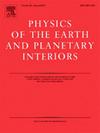Local flow estimation at the top of the Earth’s core using Physics Informed Neural Networks
IF 1.9
3区 地球科学
Q2 GEOCHEMISTRY & GEOPHYSICS
引用次数: 0
Abstract
The Earth’s main geomagnetic field arises from the constant motion of the fluid outer core. By assuming that the field changes are advection-dominated, and that diffusion only plays a minor role, the fluid motion at the core surface can be related to the secular variation of the geomagnetic field, providing an observational approach to understanding the motions in the deep Earth. The majority of existing core flow models are global, showing features such as an eccentric planetary gyre, with some evidence of rapid regional changes. By construction, the flow defined at any location by such a model depends on all magnetic field variations across the entire core–mantle boundary: because of this nonlocal dependence of the flow on the magnetic field, it is very challenging to interpret local structures in the flow as due to specific local changes in magnetic field. Here we present an alternative strategy in which we construct regional flow models that rely only on local secular changes. We use a novel technique based on machine learning termed Physics-Informed Neural Networks (PINNs), in which we seek a regional flow model that simultaneously fits both the local magnetic field variation and dynamical conditions assumed satisfied by the flow. Although we present results using the Tangentially Geostrophic flow constraint, we set out a modelling framework for which the physics constraint can be easily changed by altering a single line of code. After validating the PINN-based method on synthetic flows, we apply our method to the CHAOS-8.1 geomagnetic field model, itself based on data from Swarm. Constructing a global mosaic of regional flows, we reproduce the planetary gyre, providing independent evidence that the strong secular changes at high latitude and in equatorial regions are part of the same global feature. Our models also corroborate regional changes in core flows over the last decade. In our models, we find that the azimuthal flow under South America has changed sign quasi-periodically, with a recent sign change in 2022. Furthermore, our models endorse the existence of a dynamic high latitude jet, which began accelerating around 2005 but has been weakening since 2017.

利用物理信息神经网络估算地核顶部的局部流量
地球的主要地磁场是由流体外核的不断运动产生的。假设磁场变化以平流为主,扩散只起次要作用,那么地核表面的流体运动可以与地磁场的长期变化联系起来,为了解地球深部的运动提供了一种观测方法。现有的大多数地核流模型都是全球性的,显示出偏心行星环流等特征,并有一些证据表明存在快速的区域变化。通过构造,这种模型在任何位置定义的流动取决于整个核心-地幔边界上的所有磁场变化:由于流动对磁场的非局部依赖,将流动中的局部结构解释为由于特定的局部磁场变化而非常具有挑战性。在这里,我们提出了一种替代策略,其中我们构建仅依赖于局部长期变化的区域流量模型。我们使用了一种基于机器学习的新技术,称为物理信息神经网络(pinn),在该技术中,我们寻求一个区域流模型,该模型同时适合局部磁场变化和假定流满足的动态条件。虽然我们使用切向地转流约束呈现结果,但我们设置了一个建模框架,其中物理约束可以通过更改一行代码轻松更改。在对基于pass的方法进行综合流验证后,我们将该方法应用于基于Swarm数据的chaoos -8.1地磁场模型。通过构建区域流的全球马赛克,我们重现了行星环流,为高纬度和赤道地区强烈的长期变化是同一全球特征的一部分提供了独立的证据。我们的模型也证实了过去十年核心流动的区域变化。在我们的模型中,我们发现南美洲的方位流是准周期性地改变符号的,最近的符号变化是在2022年。此外,我们的模型证实了动态高纬度急流的存在,该急流在2005年左右开始加速,但自2017年以来一直在减弱。
本文章由计算机程序翻译,如有差异,请以英文原文为准。
求助全文
约1分钟内获得全文
求助全文
来源期刊

Physics of the Earth and Planetary Interiors
地学天文-地球化学与地球物理
CiteScore
5.00
自引率
4.30%
发文量
78
审稿时长
18.5 weeks
期刊介绍:
Launched in 1968 to fill the need for an international journal in the field of planetary physics, geodesy and geophysics, Physics of the Earth and Planetary Interiors has now grown to become important reading matter for all geophysicists. It is the only journal to be entirely devoted to the physical and chemical processes of planetary interiors.
Original research papers, review articles, short communications and book reviews are all published on a regular basis; and from time to time special issues of the journal are devoted to the publication of the proceedings of symposia and congresses which the editors feel will be of particular interest to the reader.
 求助内容:
求助内容: 应助结果提醒方式:
应助结果提醒方式:


